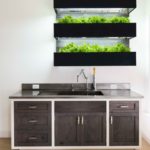It is only in the past few decades that green walls have become a way for displaying, using and enjoying plants in workplaces, public institutions and homes. New techniques and materials are being introduced which allow green walls of various sizes to be more easily and successfully enjoyed. Research is also revealing a growing appreciation of the health benefits of plants in peoples’ environments.
Types of Green Walls – Green walls are defined as all forms of vegetated wall surfaces. These include living wall systems which may be composed of pre-vegetated panels, modules, planted blankets or bags affixed to a structural wall or free-standing frame.
Exterior green walls can thrive in tropical and temperate climates or flourish for a few months in harsher climates. The focus of this blog is on interior green walls, which can remind those of us living in cold, wintry climates of milder days.
Some interior green walls are designed as bio-filters for buildings, with air passed through the wall, plant and microbe filter, resulting in ‘virtual outside air’. These can be very large and many stories high.
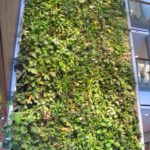 University of Ottawa, 2016
University of Ottawa, 2016
Other green walls may have automatic watering systems, water reservoirs or periodic watering by hand, with materials to absorb and distribute water to the plant roots. Sizes vary from very substantial to small, framed units for a few plants. Plants can be attached in several ways including being rooted in mats, held in bags or cupped.
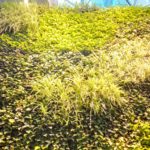
 Flaherty Building, 2017 / Plant Connections, 2014
Flaherty Building, 2017 / Plant Connections, 2014
Plant Selection – While plant selection for green walls follows many of the same considerations for selecting plants for other garden or indoor uses, there are some other considerations to bear in mind.
Compatible Plant Needs – Since the indoor environment has fairly uniform temperatures throughout the year, tropical plants are generally best. Plants that need periods of dormancy with freezing or cool temperatures or dry periods, are not suitable. While plants can be rotated or substituted, this could involve many plants, particularly for the larger units.
Light levels need to be considered when selecting and placing plants, especially as indoor light levels are much lower than most outdoor areas. Sun-loving plants can be placed closer to light sources, and light augmented by light fixtures, particularly in the winter when the sun is low.
With regard to watering needs, compatible plants can be placed together where they might create small micro-climates, with higher humidity levels, for example. Due to their ability to retain water, along with their attractive appearance, various bromeliads are used in some green walls. Be aware that piped municipal water may be very cold in winter or contain fluoride, to which plants such as spider plants (Chlorophytum comosum) are sensitive.
Trailing and climbing plants, such as philodendrons (Philodendron scandens), and pothos (Epipremnum aureum) as well as plants which naturally grow in trees, such as many bromeliads and orchids, are very suited to green walls. Many plants can do well, especially in green walls where they are well rooted or able to grow vertically easily.
Scale and Texture – In large green walls, especially those which may be viewed from afar, plants with large and dramatic leaves such as crotons (Codiaeum variegatum), Umbrella Bush (Schefflera arboricola) and even saplings of fig and rubber trees (Ficus elastica or Ficus lyrata) can be used. Periodic trimming can help keep them in balance with other plants. For some small green walls which are viewed up close, varieties of ferns, Spikemoss (Selaginella), peperomia and begonias with small leaves and/or interesting textures can be ideal.
 Plant details, University of Ottawa, 2016
Plant details, University of Ottawa, 2016
Colours and Patterns – While flowering plants such as orchids can be used, generally leaf colours and patterns are featured in green walls. Plants can spill beyond the frames or waves of vegetation can be created with the use of plants such as spider plants, philodendrons, and pothos. Rather formals walls can be created as well, featuring different varieties and colours of these same plants or bromeliads.
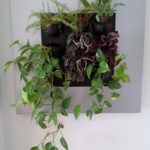
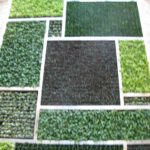 Ottawa, 2017 / Minto Plaza, 2016
Ottawa, 2017 / Minto Plaza, 2016
Herbs and Microgreens – For those wishing fresh herbs and microgreens throughout the year, some simple as well as special green wall units are available.
Conclusion – Green walls are becoming more readily available not only in large institutional spaces but in office and residential areas as well. Many plants can be used in these settings and plants selected to suit particular spaces can help foster health benefits and create beauty, interest and enjoyment.



